The Ultimate Guide to Harvesting Your Garden: When and How to Pick Common Crops

Harvesting your garden at the right time is crucial to keep your plants healthy and producing. Whether you're a newbie or a seasoned gardener, knowing the best practices for harvesting can make a huge difference in your harvest. Let's dive into the basics, go over some common crops, and give you tips for everything else.
Harvesting Basics
Why Timing Matters
Harvesting at the right time gives you the best flavor, texture, and nutrition from your produce. It also keeps your plants producing more goodies for longer.
General Harvesting Tips
-
Check Maturity Dates: Your seed packet or plant label usually gives you a rough idea of when your crop will be ready.
-
Look for Visual Cues: Color, size, and firmness are good indicators. Each crop has its specific signs.
-
Feel the Fruit: Most fruits and veggies should be firm but not hard. Avoid those that are overly soft or mushy.
-
Use the Right Tools: Sharp knives, pruning shears, or scissors prevent damage to your plants.
-
Harvest Regularly: Pick often to encourage more production and avoid overripening.
-
Handle with Care: Be gentle to prevent bruising or damaging your harvest.
How and When to Harvest Common Crops
Tomatoes
-
When to Harvest: Pick when they are fully colored and slightly soft to the touch.
-
How to Harvest: Gently twist the fruit until it releases from the vine or use pruning shears.
-
Tips: Don't refrigerate fresh tomatoes to keep their flavor. Check plants often and pick ripe tomatoes to encourage more growth.
-
Avoid: Don’t pull tomatoes off the vine forcefully, as this can damage the plant and affect future fruiting.
Cucumbers
-
When to Harvest: Pick when firm and the desired size. Pickling cucumbers should be 2-4 inches long; slicing cucumbers, 6-8 inches.
-
How to Harvest: Cut the stem about 1/4 inch above the fruit with a sharp knife or shears.
-
Tips: Frequent harvesting boosts production. Don’t let cucumbers overripe on the vine.
-
Avoid: Be careful not to yank cucumbers off the vine, as this can damage the plant and reduce future yields.
Zucchini
-
When to Harvest: Best at 6-8 inches long.
-
How to Harvest: Use a sharp knife to cut the stem about 1 inch above the fruit.
-
Tips: Zucchini grows fast, so check daily. Overgrown zucchini can be tough.
-
Avoid: Don’t twist or pull the zucchini off, as this can damage the plant.
Lettuce
-
When to Harvest: Pick leaves when they are big enough to eat. For head lettuce, harvest when the head is firm.
-
How to Harvest: Cut outer leaves from the base for leaf lettuce. Cut the entire head at the base for head lettuce.
-
Tips: Harvest in the morning when leaves are crisp. Regularly picking leaves encourages new growth.
-
Avoid: Don’t pull leaves forcefully; use a sharp knife or scissors to avoid damaging the plant.
Carrots
-
When to Harvest: Usually ready when they are about 1/2 to 1 inch in diameter.
-
How to Harvest: Loosen the soil around the carrot with a garden fork and gently pull it out by the greens.
-
Tips: Water the soil before harvesting to make pulling easier. Don’t let them become woody.
-
Avoid: Don’t pull carrots out without loosening the soil first, as this can break the carrots and damage the roots.
Peppers
-
When to Harvest: Pick when they reach full size and color. Green peppers can be picked before they change color.
-
How to Harvest: Use a sharp knife or scissors to cut the stem about 1/2 inch above the fruit.
-
Tips: Regular harvesting encourages more production. Handle gently to avoid bruising.
-
Avoid: Don’t pull peppers off the plant as this can break branches and harm the plant.
Harvesting Other Crops
Identifying Ripeness
For crops not listed, here are some general guidelines:
-
Root Vegetables: Look for the tops of the roots peeking out of the soil. Check size and firmness.
-
Leafy Greens: Harvest leaves when they are big enough to eat but still tender.
-
Fruiting Vegetables: Like tomatoes and peppers, these are usually ready when fully colored and slightly soft.
-
Herbs: Harvest just before they flower for the best flavor. Cut back stems to encourage bushy growth.
Proper Harvesting Techniques
-
Use Sharp Tools: Clean, sharp tools prevent plant damage.
-
Support the Plant: Hold the plant steady with one hand while cutting or pulling with the other.
-
Store Correctly: Different crops need different storage methods. Some need refrigeration; others do better at room temperature.
-
Avoid: Don’t yank or pull produce off the plant. Always use a clean cut to avoid stressing the plant.
Harvesting your garden doesn't have to be complicated. By following these tips for common crops and applying general guidelines for others, you can keep your plants healthy and productive. Remember, regular harvesting promotes more growth and better yields. Happy gardening, and enjoy the fruits (and veggies) of your labor!
Metal raised beds can make the whole process easier. They offer excellent drainage, better pest control, and an organized space that simplifies harvesting. Sign up for our email community and get $35 off your first order of metal raised garden beds and other gardening essentials!
For more gardening tips and tricks, check out the rest of our article library.
Happy harvesting!



